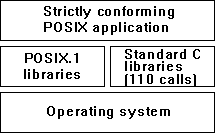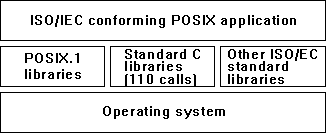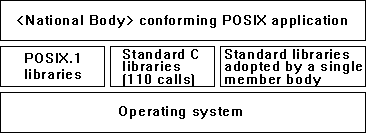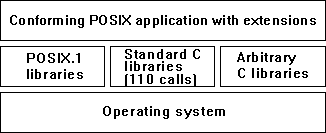
For POSIX.1, there are four categories of compliance, ranging from a very strict compliance to a very loose compliance. The various categories are described in this section.
The current release of Windows NT supports strictly conforming POSIX.1 applications and ISO/IEC conforming POSIX.1 applications. Windows NT supports the latter by virtue of the fact that only 110 of the 149 functions of standard C are part of POSIX.1, and standard C is itself an ISO standard (ISO/IEC 9899).
A strictly conforming POSIX.1 application requires only the facilities described in the POSIX.1 standard and applicable language standards. This type of application accepts the following conditions:
This is the strictest level of application conformance, and applications at this level should be able to move across implementations with just a recompilation. At this time, the only language interface that has been standardized for POSIX.1 is the C-language interface. (As shown in the figure below, a strictly conforming POSIX application can use 110 calls from the standard C libraries.)

Figure 17.1 A Strictly Conforming POSIX Application
An ISO/IEC-conforming POSIX.1 application is one that uses only the facilities described in ISO/IEC 9945-1 and approved conforming language bindings for the ISO or IEC standard. This type of application must include a statement of conformance that documents all options and limit dependencies, and all other ISO or IEC standards used.

Figure 17.2 An ISO/IEC-conforming POSIX.1 Application
This level of conformance is not as strict as the previous one for two reasons. First, it allows a POSIX.1 application to make use of other ISO or IEC standards, such as GKS. Second, it allows POSIX.1 applications within this level to require options or limit values beyond the minimum. For example, such an application could require that the implementation support filenames of at least 16 characters. The POSIX.1 minimum is 14 characters.
A <National Body> conforming POSIX.1 application differs from an ISO/IEC-conforming POSIX.1 application in that this type of application may also use specific standards of a single ISO/IEC organization, such as ANSI or British Standards Institute (BSI). This type of application must include a statement of conformance that documents all options and limit dependencies, and all other <National Body> standards used.
For example, you could have a <National Body> conforming POSIX application that uses calls from a BSI-standard set of calls.

Figure 17.3 A National Body Conforming POSIX.1 Application
A conforming POSIX.1 application using extensions is an application that differs from a conforming POSIX.1 application only because it uses nonstandard facilities that are consistent with ISO/IEC 9945-1. Such an application must fully document its requirements for these extended facilities.

Figure 17.4 A Conforming POSIX.1 Application Using Extensions
This is the lowest level of conformance; almost any C program could satisfy this with the appropriate documentation.